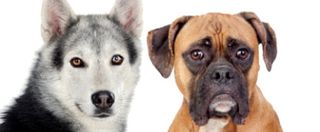Few Genetic Variations Separate Great Danes and Dachshunds

The difference between a pug's smashed schnoz and the narrow muzzle of a dachshund depends on just one small segment of genes, according to a new study.
The findings, published today in the journal Public Library of Sciences – Biology, are the most comprehensive genetic analysis of domestic dogs to date, and could have an impact on human genetics, the researchers say.
Diverse doggies
Thanks to years of breeding for function and form, dogs are now the physically most diverse land animal, according to Stanford University. What researchers didn't know was whether the differences between Great Danes and chihuahuas or shar-peis and whippets was caused by lots of little genetic changes adding up, or just a few big changes.
To find out, Stanford professor of genetics Carlos Bustamante and his colleagues analyzed more than 60,000 single genetic changes known as single nucleotide polymorphisms, or SNPs for short, in 915 dogs. The dogs included representatives of 80 domestic breeds, 83 wild canids such as wolves, foxes and coyotes, and 10 Egyptian village dogs — domesticated but of no particular breed.
The researchers used the SNPs to identify chunks of DNA shared among individual dogs of the same breed. They found that while purebred dogs tended to share large stretches of DNA with other members of their breed, the wild dogs and village mongrels were more variable. The researchers then looked to see which regions varied with specific physical traits from breed to breed.
They found that — in contrast to humans — many physical traits in dogs are determined by very few genetic regions. For example, a dog with version A of the "snout length" region of a gene may have a long, slender muzzle, while version B confers a more standard nose and C an abnormally short schnoz. If X, Y and Z in the "leg length" region bestow a range of heights from short to tall, an A/X dog would have a slender muzzle and short legs like a dachshund. C/Y might be a bulldog, while B/Z would be more like a Labrador.
Sign up for the Live Science daily newsletter now
Get the world’s most fascinating discoveries delivered straight to your inbox.
"We've found that only six or seven locations in the dog genome are necessary to explain about 80 percent of the differences in height and weight among dog breeds," said Bustamante, PhD. "In humans these are controlled by hundreds if not thousands of variants."
This mixing and matching of chunks of DNA is how breeders were able to come up with so many different breeds in a relatively short amount of time.
"This dizzying array of morphological variants has happened extraordinarily quickly in terms of evolutionary timescales, due to extraordinarily strong selection by humans," said Bustamante. "Most dog breeds are only a couple of hundred years old."
Making sense of genetics
The findings may be for the dogs, but they could eventually help researchers understand human traits, such as height, hair color, and body weight. The idea, the researchers say, is that identifying the dozen regions where dogs harbor genetic switches among breeds will provide clues as to where researchers could find mutations important to human health and disease.
"Understanding the genetic bases of complex traits in humans is difficult because many different genes can influence a particular trait," Bustamante said. "Having model systems, such as mice and dogs, is critical for making sense of the biology."
For example, even if dog and human cancers are different, they two diseases could be very similar at the molecular level, with cellular processes that lead to skin cancer, say, in dogs, resembling those that lead to breast cancer in women.
- The Most Popular Dog Breeds
- How Did Dogs Get to Be Dogs?
- America’s Favorite Pets
Most Popular


